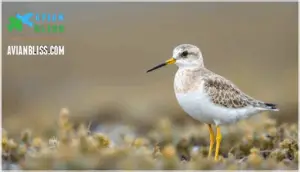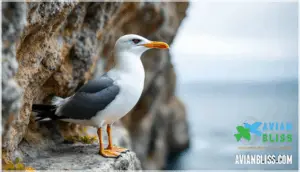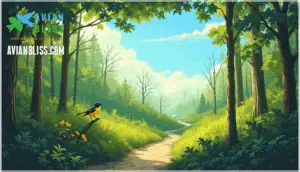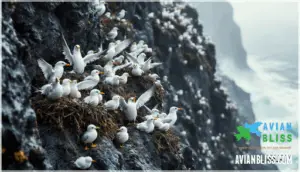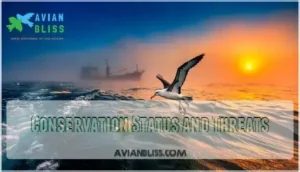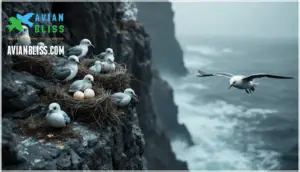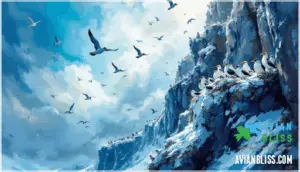This site is supported by our readers. We may earn a commission, at no cost to you, if you purchase through links.

Yet their mastery of coastal life masks a troubling reality: since 1970, their populations have plummeted 40%, driven by vanishing fish stocks and a rapidly warming ocean.
Understanding what these birds are, where they thrive, and why their numbers keep declining offers insight into the delicate balance between marine ecosystems and the creatures that depend on them. Their story reveals how interconnected ocean health truly is—and why their fate matters beyond the remote Arctic colonies where they breed.
Table Of Contents
- Key Takeaways
- Black-legged Kittiwake: an Overview
- Physical Characteristics and Identification
- Habitat and Distribution
- Behavior and Breeding Patterns
- Diet and Feeding Habits
- Conservation Status and Threats
- Taxonomy and Scientific Classification
- Life Cycle and Longevity
- Black-legged Kittiwakes in Art and Culture
- Frequently Asked Questions (FAQs)
- Where do black-legged kittiwakes live?
- What is a black-legged kittiwake?
- Are black-legged kittiwake protected?
- Are black-legged kittiwakes dying?
- Are black-legged kittiwake predators?
- How do kittiwakes interact with other seabird species?
- What parasites or diseases commonly affect kittiwakes?
- How do kittiwakes cope with extreme weather conditions?
- What are the unique vocalizations of juvenile kittiwakes?
- How do kittiwakes navigate during long oceanic migrations?
- Conclusion
Key Takeaways
- Black-legged kittiwakes have declined 40% since 1970, with some regional populations collapsing by up to 88%, primarily driven by vanishing fish stocks and rapid ocean warming that forces birds to forage farther from breeding colonies.
- These seabirds possess a unique three-toed foot structure and nearly vertical grip that enables them to nest on razor-thin cliff ledges where few other species can survive, making them specialists adapted to extreme Arctic environments.
- Climate change is fundamentally reshaping their survival by pushing prey species like sandeel and capelin northward, creating a dangerous mismatch between where birds breed and where food becomes available during critical chick-rearing periods.
- Kittiwake population trends serve as an early warning system for broader ocean health, revealing how interconnected marine ecosystems are and why protecting these birds ultimately means safeguarding the Arctic waters that support countless species.
Black-legged Kittiwake: an Overview
You’re about to meet one of the ocean’s most fascinating seabirds—the Black-legged Kittiwake (Rissa tridactyla), a medium-sized gull that’s perfectly at home riding Arctic storms. First described by Linnaeus in 1758, this species gets its memorable name from its distinctive "ki-ti-waak" call that echoes across northern cliffs.
With roughly 15 million individuals spread across two subspecies—the Atlantic tridactyla and Pacific pollicaris—these birds have mastered life in some of Earth’s harshest marine environments. You’ll find them thriving from Greenland to Siberia, though their story isn’t all smooth sailing. The IUCN now lists them as Vulnerable after population numbers dropped about 40% since 1970, making kittiwake identification and conservation more important than ever.
From Greenland to Siberia, roughly 15 million black-legged kittiwakes navigate Earth’s harshest marine environments, yet their populations have plummeted 40% since 1970, earning them vulnerable status and making their conservation increasingly urgent
What makes these birds so special? Their pelagic lifestyle sets them apart from typical gulls—they’re true ocean wanderers who only touch land to breed on sheer sea cliffs, displaying intriguing kittiwake habits that include occasional same-sex pairs and striking foraging skills. As a seabird species, the Kittiwake population is currently around 205k pairs.
Physical Characteristics and Identification
When you’re trying to spot a Black-legged Kittiwake in the field, you’ll want to know what sets it apart from other gulls. These seabirds have distinctive markings and proportions that make identification straightforward once you know what to look for.
Let’s break down the key features into plumage patterns and unique physical traits.
Plumage and Coloration
When you observe a Black-legged Kittiwake, you’re looking at a masterpiece of oceanic adaptation. These seabirds display white heads and underparts contrasted against soft pearl-gray backs and wings, with bold black wingtips that bolster feather durability under harsh marine conditions. Your plumage development unfolds over four years—juveniles begin with darker markings and black wing patterns, gradually shifting to adult coloration as carotenoids and vitamins accumulated through diet intensify their bill pigmentation from black to bright yellow. Seasonal molting cycles between May and October produce striking variations: breeding adults showcase clean plumage, while winter birds develop subtle gray smudges behind their eyes and olive-toned bills. They’re generally found near the Arctic and subarctic coasts.
- Black wingtips concentrate melanin pigments, protecting against UV damage and flight stress
- Bill coloration shifts from juvenile black to adult yellow, signaling dietary success and reproductive fitness
- Seasonal molting cycles align with migration patterns, creating distinct breeding and winter appearances
- Individual plumage variations aid long-term pair recognition and mate identification across breeding seasons
Unique Features
What truly sets the Black-legged Kittiwake apart is its three-toed foot structure—an exceptional adaptation that lets you spot this species instantly. Unlike most gulls, kittiwakes lack a functional hind toe, giving them excellent grip on razor-thin cliff ledges where they nest.
You’ll also notice their vivid red mouth interior, a sign of reproductive fitness displayed during courtship. Their legs shift from black to reddish depending on diet and season, while the bright yellow bill remains consistent year-round.
These physical characteristics work together, making identification straightforward and revealing how thoroughly this gull has specialized for its pelagic, cliff-bound life.
Habitat and Distribution
Where the Black-legged Kittiwake makes its home tells you a lot about how it survives—these birds are tied to northern waters and remote cliff faces in ways that shape everything about them.
You’ll find them scattered across vast stretches of the Atlantic and Pacific, from the Arctic down to more temperate wintering grounds, each location offering something different.
Let’s look at where they nest and how they’ve spread across the globe.
Nesting Sites
Where do Black-legged Kittiwakes build their homes? These gulls are cliff-nesting specialists, selecting dramatic coastal environments that provide safety from predators. You’ll find them constructing nests on:
- Sheer rocky sea cliffs, often directly above churning waters
- Narrow ledges just centimeters wide, perfectly suited to their small nest cups
- Urban structures like bridges and buildings near shorelines, particularly along Europe’s coasts
- Abandoned shipwrecks and offshore installations in accessible coastal zones
Their nest fidelity remains remarkably high—males return to identical ledges across breeding seasons, stabilizing colony size and structure. Constructed from mud, seaweed, and moss over 5–10 days, these bowl-shaped nests average 45 cm across, with guano accumulation often cementing them firmly to sheer surfaces, preventing slippage during colonial nesting.
Global Range
Across the Northern Hemisphere, Black-legged Kittiwakes breed along Arctic and subarctic coastlines between roughly 40°N and 80°N latitude, with over 3.79 million pairs concentrated in Alaska, Canada, Greenland, Iceland, Norway, Russia, and the United Kingdom. Their breeding distribution remains tied to suitable sea cliffs, but range contraction is reshaping their geography—colonies have vanished from Brittany while populations in the Norwegian Arctic declined 70% since 1991.
During migration, birds travel thousands of kilometers to wintering grounds spanning from Greenland waters to the Azores and occasionally beyond. Climate change and prey depletion now drive northward shifts in breeding grounds, fundamentally altering population dynamics across their entire range.
Behavior and Breeding Patterns
Black-legged kittiwakes aren’t your typical gulls—they’ve evolved some striking actions that set them apart from their relatives.
Understanding how these birds hunt, breed, and raise their young reveals what makes them so successful in the harsh Arctic environment. Here’s what you need to know about their actions and breeding patterns.
Foraging Techniques
How do kittiwakes hunt across vast ocean expanses while meeting their chicks’ relentless demands? These birds employ a bimodal foraging strategy—alternating between short local trips and offshore expeditions spanning 50+ kilometers when nearby food availability drops.
Your understanding of their prey capture techniques reveals their striking adaptability: surface seizing and dipping dominate their feeding arsenal, with plunge dives reaching shallow depths, while they exploit feeding whales and fishing vessels for additional prey access.
Environmental modulation shapes their diet composition and foraging actions; increased ocean productivity triggers offshore trips, and nocturnal foraging emerges when daytime prey scarcity intensifies competition. This habitat flexibility demonstrates how kittiwakes adjust their food availability strategies across breeding seasons, achieving predation success rates exceeding 65% during peak abundance of sandeels and pollock.
- Surface seizing captures prey within one meter of the water’s surface with minimal energy expenditure
- Plunge diving from low flight targets prey just below the surface during high food availability periods
- Nocturnal foraging and whale-following actions access alternative food sources when standard kittiwake diet composition becomes scarce
Atypical Family Structures
What drives kittiwakes to abandon traditional partnerships? These remarkably adaptive seabirds challenge our assumptions about monogamous family life. While biparental care remains their norm—both parents sharing incubation and chick-rearing duties for roughly 25 days—their social arrangements reveal surprising flexibility.
Up to 82% of pairs re-partner with the same mate annually, yet 36% dissolve between seasons. Extra-pair mating contributes less than 4% of genetic parentage, maintaining high pair fidelity despite occasional dissolution. In high-density colonies, chick adoption rates reach 12% in some years, demonstrating communal flexibility in nest defense and parental duties.
Urban nesting has recently emerged in Northern Norway and Newcastle, where 1,639 pairs now occupy buildings—suggesting kittiwakes are redefining family structures as environmental pressures reshape breeding strategies.
| Breeding Pattern | Frequency | Significance |
|---|---|---|
| Pair re-partnering | Up to 82% annually | Strong mate fidelity |
| Pair dissolution | 36% between seasons | Flexible partnerships |
| Extra-pair mating | <4% genetic parentage | High monogamy |
| Chick adoption | Up to 12% some years | Communal care |
| Urban nesting | Growing trend | Adaptive conduct |
Diet and Feeding Habits
How do these ocean wanderers actually eat? Unlike their trash-scavenging cousins, kittiwakes are committed pelagic hunters, rarely venturing inland and subsisting entirely on marine prey. Their diet consists primarily of small fish—capelin, sand eels, herring, and pollock—comprising 70–90% of their intake during breeding season, supplemented by euphausiids and copepods when fish grows scarce.
Your kittiwakes employ specialized feeding techniques uniquely suited to open water: plunge-diving, surface seizing, and remarkably, swimming underwater—a trait few gulls share. They forage within 30–50 km of colonies during breeding, maximizing energy efficiency for chick provisioning. Prey selection focuses on energy-rich species averaging 10 cm, with foraging range and dietary variation shifting seasonally and geographically across the North Atlantic and Barents Sea.
Climate impacts are reshaping their feeding ecology. Warmer ocean temperatures alter prey distribution, forcing extended foraging trips and straining breeding success.
- Selective prey targeting of high-lipid sand eels and capelin for best chick growth
- Surface feeding within 1 meter depth, occasionally diving to 3 feet while pursuing prey
- Regional dietary variation: capelin dominance in Barents Sea versus sand eel preference in North Sea
- Seasonal diet shifts toward zooplankton during nonbreeding periods when foraging pelagically offshore
Conservation Status and Threats
Black-legged kittiwakes face serious challenges today, with their populations dropping dramatically over the past three decades. You’ll want to understand what’s driving this decline and why these arctic gulls matter to ocean health.
We’ll walk through the key threats and what scientists are learning about their future.
Population Trends
Black-legged kittiwake populations tell a cautionary tale: while roughly 14.6 million mature individuals remain globally, regional declines paint a starkly different picture. Since 1991, breeding populations have collapsed across monitoring regions—64% in the Greater North Sea, 58% in Celtic Seas, and a devastating 88% in Arctic Norway.
These population threats stem directly from three interconnected factors:
- Reduced abundance of small pelagic fish (sandeel, sprat, herring) essential to their diet
- Regional declines concentrated near southern range limits where warming disrupts breeding habitats
- Breeding productivity remaining below sustainable thresholds despite recent modest recovery
Conservation indicators show that achieving 1.0 chick per breeding pair annually is essential to halt further decline. Continuous monitoring programs track these recovery patterns, revealing that stabilization requires immediate intervention addressing both food availability and ecosystem health.
Climate Change Impacts
Warming oceans fundamentally reshape how kittiwakes survive. Rising sea temperatures drive prey like sandeel and capelin northward, forcing birds to forage beyond their traditional feeding grounds—a mismatch that’s devastated breeding success across monitored colonies. Between 1991 and 2020, this prey availability crisis helped trigger a 67% population collapse in key regions.
Beyond food scarcity, sea level rise threatens cliff nesting sites, while increased storm frequency compounds breeding failures. These climate threats converge with emerging pressures like offshore wind development and avian influenza, creating cascading ecosystem resilience challenges.
Halting population decline demands immediate action: protecting marine productivity through fishery management and reducing non-climate stressors to buffer kittiwakes against ongoing global warming impacts.
Taxonomy and Scientific Classification
Understanding where the Black-legged Kittiwake fits in the avian world reveals much about its evolutionary success. Scientifically named Rissa tridactyla, this gull belongs to the order Charadriiformes and family Laridae, placing it alongside terns and other gulls. The genus Rissa derives from Icelandic "rita," while "tridactyla" refers to its three-toed feet—a distinctive trait within its family.
Taxonomic history shows Carl Linnaeus first described the species in 1758 as Larus tridactylus, later reclassified under Rissa in 1826. Two subspecies diverge geographically: the Atlantic R. t. tridactyla and the larger Pacific R. t. pollicaris.
Genomic studies reveal the kittiwake shares recent divergence with the Red-legged Kittiwake, with phylogenetic analysis confirming their close relationship through mitochondrial DNA comparisons. These taxonomic and nomenclature details demonstrate how genetic and morphological evidence illuminates the kittiwake’s place among gull species and avian evolution broadly.
Life Cycle and Longevity
These oceanic birds reach sexual maturity between 3 and 5 years of age, commonly returning to their natal colonies to breed annually with moderate pair fidelity—about 64% reunite across seasons. Once established, breeding frequency follows a predictable rhythm: single clutches of one to three eggs, most commonly two, incubated for 25–32 days by both parents.
Chick survival rates remain modest, often below 50% under resource-limited conditions, as siblicide favors the eldest among competing juveniles during the first 10 days post-hatching. Fledging occurs after 34–58 days, with juveniles remaining at sea for several years before returning to breed.
Adult kittiwakes live 12–20 years in the wild, with documented individuals reaching 28 years. Migration patterns carry immatures across thousands of kilometers during non-breeding seasons, while adults balance energetic costs of reproduction against survival rates—0.85–0.90 annually under stable conditions.
These lifespan factors reveal how breeding investment, prey availability, and climate variability shape individual longevity across populations.
Black-legged Kittiwakes in Art and Culture
Your kittiwake’s long life—spanning decades at sea—tells only part of its story. These striking birds have captured human imagination across centuries, inspiring artists, writers, and communities worldwide.
Their striking plumage and dramatic cliff-nesting actions appear in over 700 professional artworks and stock illustrations, from fine art prints to contemporary wildlife photography. Writers use them as symbols of Arctic freedom and resilience, while Indigenous Alaskan traditions link their actions to weather prediction and spiritual guidance.
Today, conservation photographers and environmental organizations employ kittiwake imagery to communicate the urgency of climate action. Through paintings, poetry, and media campaigns, the species embodies our complex relationship with marine ecosystems—a living reminder of what we stand to lose.
Frequently Asked Questions (FAQs)
Where do black-legged kittiwakes live?
Imagine a bird that treats the open ocean like your commute. Black-legged kittiwakes inhabit northern Atlantic and Pacific coasts, from Canada to Siberia, rarely venturing inland except during breeding season when they nest on sheer sea cliffs.
Their pelagic lifestyle keeps them far offshore, with wintering grounds spanning the St. Lawrence, southern New Jersey, and West African coasts—showing striking regional variations in habitat preferences.
What is a black-legged kittiwake?
A small northern seabird named for its distinctive "ki-ti-waak" call, the black-legged kittiwake (Rissa tridactyla) is a pelagic gull adapted to life at sea.
You’ll recognize this coastal gull by its white plumage, grey back, sharply black-tipped wings, yellow bill, and characteristic black legs—making it one of the ocean’s most specialized seabird adaptations.
Are black-legged kittiwake protected?
Legal protections for these seabirds operate through multiple frameworks. The Migratory Bird Treaty Act shields them in North America, while international agreements and conservation laws safeguard populations globally.
Listed as vulnerable on the IUCN Red List, they’re subject to habitat preservation efforts and population monitoring programs addressing climate change and pollution threats.
Are black-legged kittiwakes dying?
Yes, black-legged kittiwakes face serious population decline. Their global numbers dropped from 18 million in the early 1990s to fewer than 12 million by 2020, with breeding pairs declining 67% in monitored regions.
Climate change, food scarcity, and habitat loss drive these conservation concerns threatening their survival.
Are black-legged kittiwake predators?
What hunts the hunter? Though kittiwakes are skilled predators, they’re not top hunters—they’re carnivorous surface feeders targeting small fish and invertebrates up to 20 cm long.
Their true vulnerability lies elsewhere: marine mammals, larger seabirds, and foxes pose genuine predator threats, while their populations face steeper decline from climate change and ecosystem disruption than from predation alone.
How do kittiwakes interact with other seabird species?
Kittiwakes share nesting cliffs and open waters with auks, cormorants, and other gulls, creating vibrant mixed colonies where you’ll witness both cooperation and competition.
These seabirds navigate interspecies coexistence through spatial partitioning—each species claims specific ledge heights and depths—while feeding flocks exhibit symbiotic relationships that boost collective foraging efficiency and predation vigilance.
What parasites or diseases commonly affect kittiwakes?
Seabirds harbor invisible threats beneath spotless plumage. Marine parasites—including lice, mites, and blood parasites like Haemoproteus—compromise kittiwake health, while avian influenza and salmonella pose serious disease risks.
Marine pollution weakens immune responses, amplifying conservation implications for vulnerable populations already stressed by ecosystem changes and population decline.
How do kittiwakes cope with extreme weather conditions?
When storms roll in, these birds rely on impressive physiological adaptations and behavioral strategies. Their densely layered, waterproof plumage traps warmth while shedding water, and they’ll huddle together on cliff ledges for shared body heat.
During food scarcity caused by severe weather, kittiwakes reduce activity and draw on fat reserves, adjusting foraging patterns when conditions permit.
Climate change intensifies these survival pressures, extending breeding impacts as unpredictable storms disrupt nesting success and food availability across their Arctic habitats.
What are the unique vocalizations of juvenile kittiwakes?
Listen closely to a crowded breeding colony, and you’ll hear something striking: juvenile kittiwakes don’t simply mimic their parents’ famous "kittiwake" calls. Instead, these young birds produce high-pitched, raspy "waaah" vocalizations—distinct distress signals that communicate hunger and separation anxiety to parents traversing the chaos.
Through call development and parental recognition, juveniles learn dialects unique to their colony, mastering alarm calls that alert siblings to danger while gradually adopting adult communication patterns essential for survival in pelagic environments.
How do kittiwakes navigate during long oceanic migrations?
During migrations, your kittiwakes rely on multiple sensory mechanisms working in concert. They navigate using Earth’s magnetic fields as an internal compass, read celestial cues from stars and sun, and follow learned migration patterns passed through social learning.
Ocean currents and wind patterns serve as additional guides, helping them locate distant wintering grounds across oceanic expanses.
Conclusion
As ocean temperatures shift and fish populations dwindle, the black-legged kittiwake stands as a harbinger of change, its cliff-side colonies growing quieter each year.
Yet understanding these birds—their precise cliff-clinging grip, their breeding cycles, their dietary dependence on Arctic prey—offers you a window into marine ecosystem health.
Your awareness of their plight connects you to broader ocean conservation, reminding us that protecting these elegant gulls ultimately means safeguarding the interconnected waters we all depend on.
- https://oap.ospar.org/en/versions/2631-en-1-0-0-black-legged-kittiwake/
- https://assets.publishing.service.gov.uk/media/6808da203bdfd1243078e772/Kittiwake_information_and_resources_signposting.pdf
- https://animaldiversity.org/accounts/Rissa_tridactyla/
- https://digitalcommons.usf.edu/cgi/viewcontent.cgi?article=19326&context=auk
- https://en.wikipedia.org/wiki/Black-legged_kittiwake

